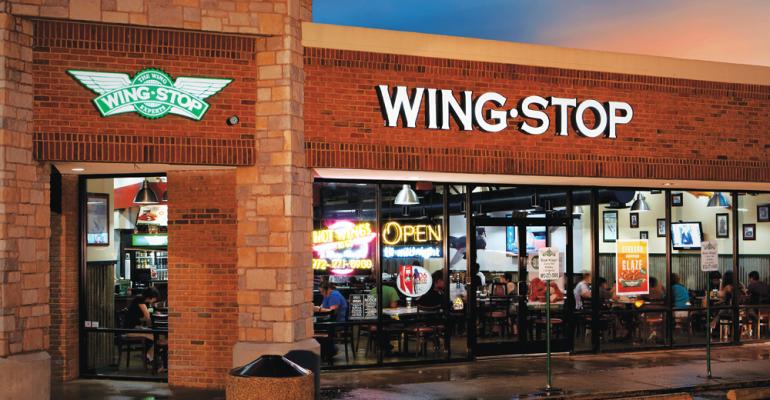Lower chicken wing prices significantly improved operating margins at Wingstop Inc.’s company-owned restaurants in the third quarter, company executives said Monday.
Domestic systemwide same-store sales also rose 6.3 percent in the quarter ended Sept. 29, driven by increased transactions and a growth in average transaction size, said Michael Skipworth, Wingstop chief financial officer, in a post-earnings analyst call.
“Cost of sales decreased as a percentage of company-owned restaurants sales by 1,300 basis points,” Skipworth said. The Dallas-based company owns and operates 26 of its more than 1,200 units.
“The decrease was primarily driven by a 970-basis-point reduction in food, beverage and packaging costs due to a 30 percent deflation in wing prices compared to Q3 of last year,” he explained.
Skipworth said deflation is expected to moderate from the third-quarter pace as the company begins to cycle over the decline in wing prices that began in October 2017, but fourth-quarter wing deflation is still expected to be in the mid- to high-single-digit range.
Bone-in chicken wing prices skyrocketed in the middle of 2017, leading Wingstop to increase prices and also offer split-menu pricing to entice customers to shift orders away from higher-cost options.
“Wings can be volatile in terms of that commodity is impacted at any given point through a year,” said Charlie Morrison, Wingstop CEO. “But certainly in 2017, those returns were stressed based on the strong wing inflation. And this year, where we’ve seen some deflation, it certainly is helping margins and therefore improving the returns.”
Morrison said attendees at Wingstop’s recent franchisee convention said they were seeing similar margin improvements.
“This margin improvement further enhances our best-in-class unit-level economics,” he said. The company’s domestic target year-one average unit volume is $820,000, with cash-on-cash return of between 35 percent and 40 percent, Morrison said.
At the chain’s domestic system average unit volume of $1.1 million, returns can exceed 50 percent, he said.
Other efficiencies at Wingstop include the continued expansion of its digital channels, Morrison said.
Digital sales rose 360 basis points over the third quarter 2017 to 25.4 percent of the brand’s total sales in the most recent period, he said.
“Almost 80 percent of the entire domestic restaurant base now generates more than 20 percent of sales from digital channels, which is up from 75 percent in Q2,” Morrison said.
Digital checks run about $5 higher than the non-digital average check of $17, Morrison said, and the company is continuing to deploy initiatives to expand that revenue.
“Our goal is to digitize every Wingstop transaction,” he said.
Wingstop’s custom-built smartphone app and website are to start testing this quarter, he said, and it will be the platform on which the company rolls out delivery nationwide.
Wingstop launched its first delivery test in 2017 in Las Vegas, Nev., and expanded it to Chicago and Austin, Texas.
“In all three test markets, we experienced sustained mid- to high-single-digit sales lifts,” Morrison said. “We have been able to demonstrate that the lift in sales from delivery is highly incremental and profitable at the restaurant level.”
The company started its national rollout this month in Denver, which has 20 Wingstop units.
“Denver was a logical next step for us because it presented a smaller, easier to manage market for validating our delivery playbook and it is a strong market for DoorDash, our third-party delivery partner,” he said.
The company will launch delivery in the Los Angeles market in November and then move to Houston, Morrison said, which will cover about a quarter of the domestic footprint by the end of this year.
“We believe by the end of 2019, we should have delivery available to over 80 percent of the domestic system,” Morrison said.
For the third quarter ended Sept. 29, Wingstop’s net income rose 33.8 percent to $6.3 million, or 21 cents a share, from $4.7 million, or 16 cents a share, in the same period a year ago. Revenue in the quarter increased 15.5 percent to $38.2 million from $33.1 million in the prior-year period.
Systemwide restaurant count increased 11.7 percent, to 1,215 global locations, in the quarter, but the company said it was severing its franchise relationship this month in the Philippines market, which it entered four years ago. The company is closing the 11 restaurants in that country.
“We do not have any other situations similar to the Philippines and remain confident that we have the right partners in the right countries as we continue our growth journey overseas,” Morrison said.
As of Sept. 29, 2018, Wingstop had 1,215 restaurants systemwide. This included 1,085 restaurants in the United States, of which 1,059 were franchised restaurants and 26 were company-owned. The company has 130 franchised restaurants in nine other countries.
Contact Ron Ruggless at [email protected]
Follow him on Twitter: @RonRuggless





